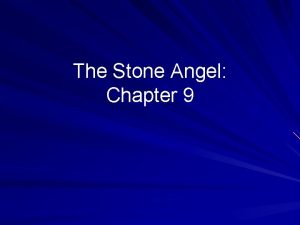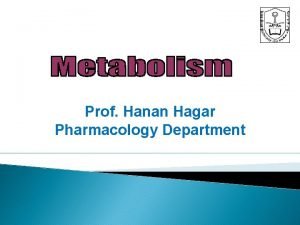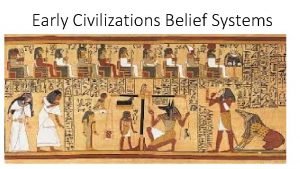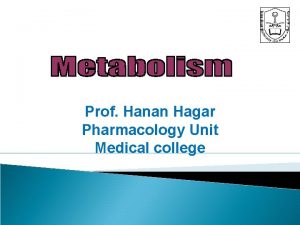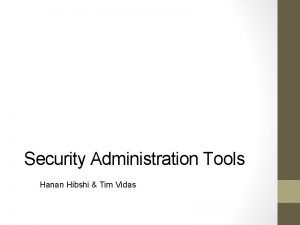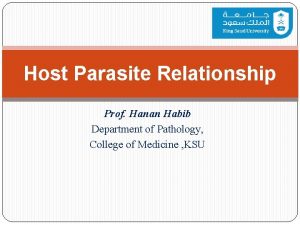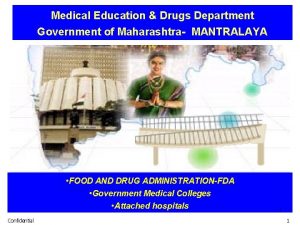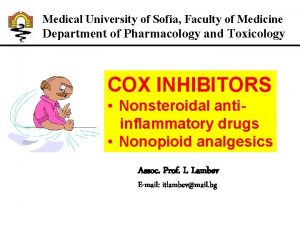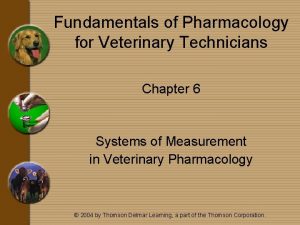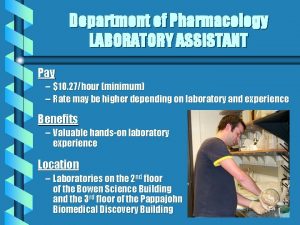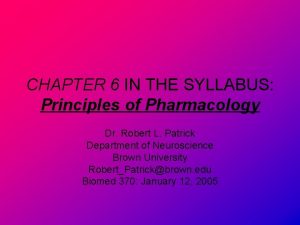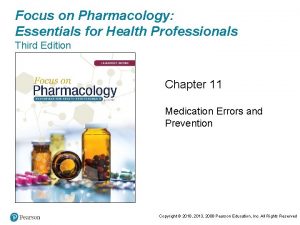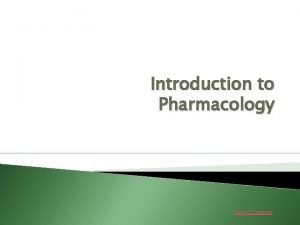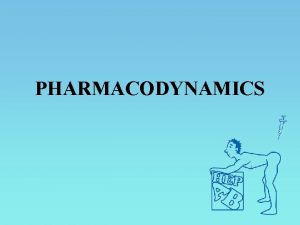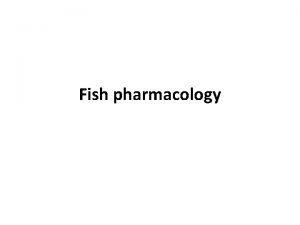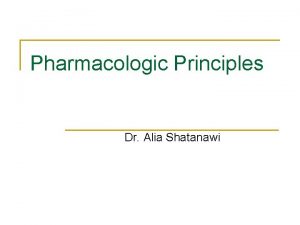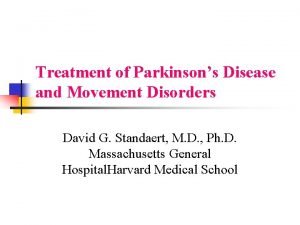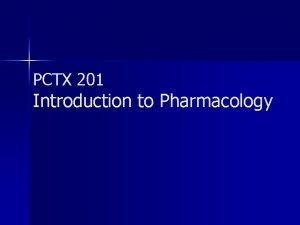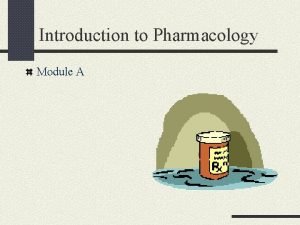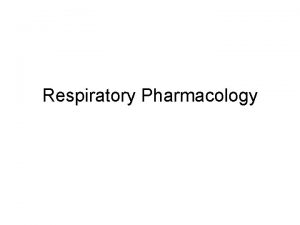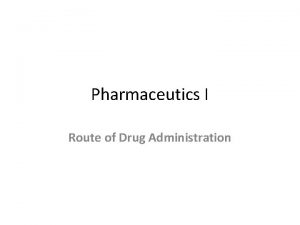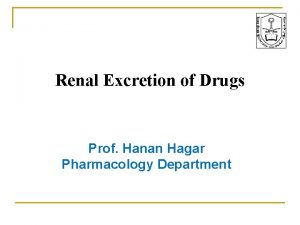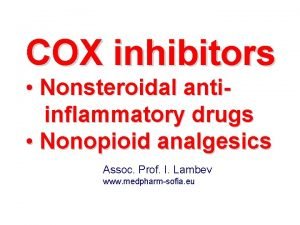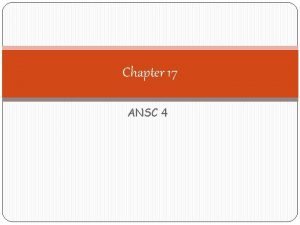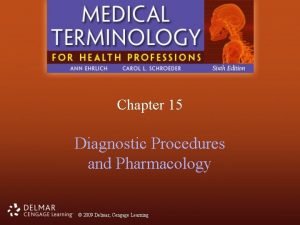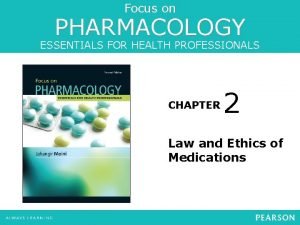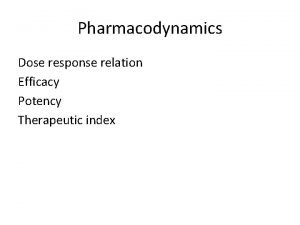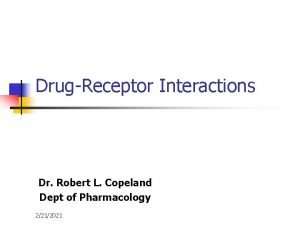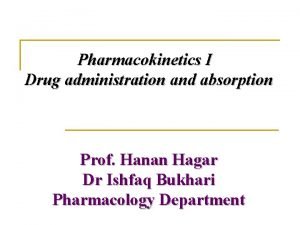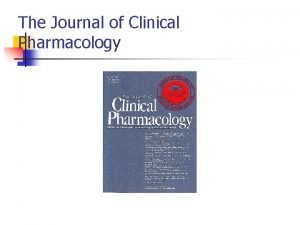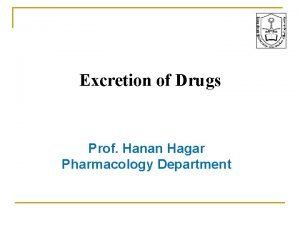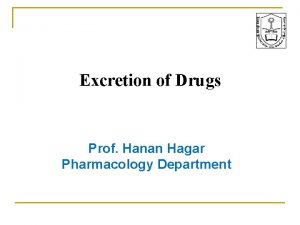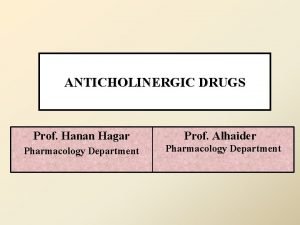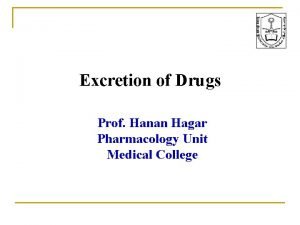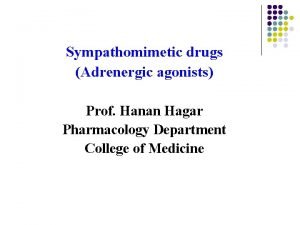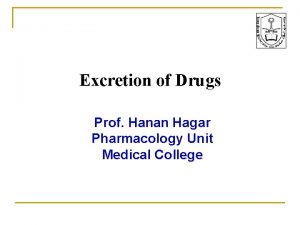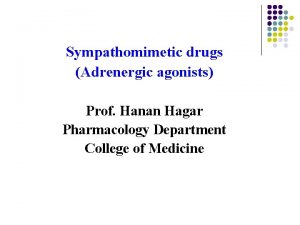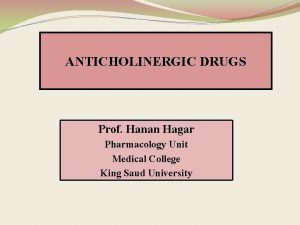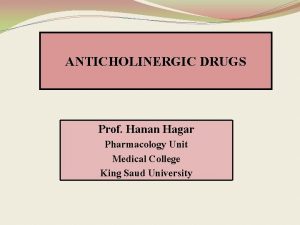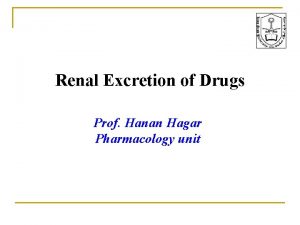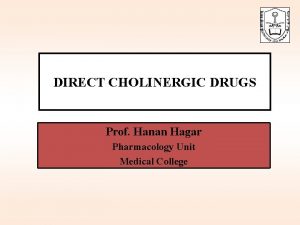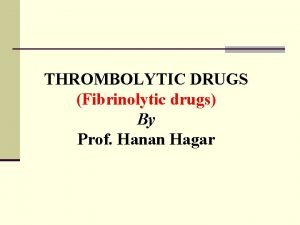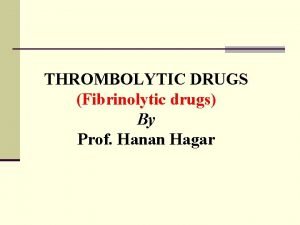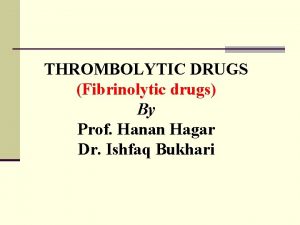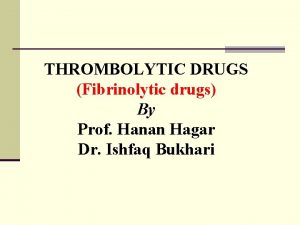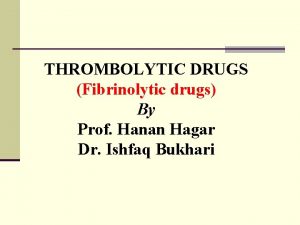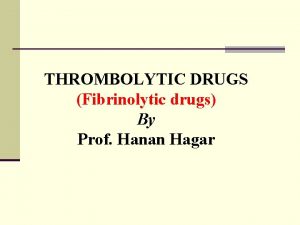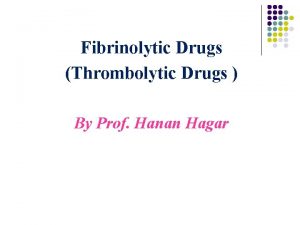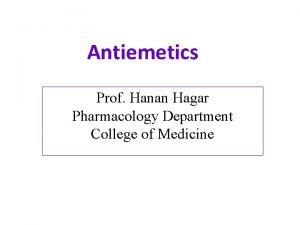Antianxiety drugs Prof Hanan H Hagar Pharmacology Department






































- Slides: 38

Antianxiety drugs Prof. Hanan H. Hagar Pharmacology Department College of Medicine

Anxiety o o o I have a presentation I have a tough exam I have an important interview Should I be anxious ?

What is anxiety ? Physical and emotional distress which interfere with normal life.

What are different symptoms of anxiety ? Psychic or emotional state. o Somatic or physical symptoms. o

Common Emotional Symptoms of anxiety o irrational and excessive fear and worry o Irritability o Restlessness o Trouble concentrating o Feeling tense

Common Physical Symptoms of Anxiety Sweating Tachycardia Stomach upset Shortness of breath Frequent urination or diarrhea Sleep disturbances (Insomnia) Fatigue

Types of anxiety 1. Generalized anxiety disorder 2. Post-traumatic stress disorder (PTSD). 3. Obsessive-compulsive disorder (OCD). 4. Panic disorder 5. Phobia

Generalized Anxiety Disorder (GAD) o Patients are usually and constantly worried about health, money, work with no apparent reasons.

Obsessive-Compulsive Disorder (OCD) An anxiety disorder in which people cannot prevent themselves from unwanted thoughts or behaviors that seem impossible to stop as Washing their hands

Panic disorder An disorder in which people have sudden and intense attacks of anxiety in certain situations.

Post-traumatic stress disorder (PTSD)

Phobia An intense, uncontrolled fear of a specific situation such as open spaces & heights

Treatment of anxiety o Psychotherapy (cognitive behavioral therapy). o Anxiolytics

Classification of anxiolytic drugs: 1. Benzodiazepines ( BDZ ). 2. 5 HT 1 A agonists. 3. 5 HT reuptake inhibitors. 4. Antidepressants 5. beta-adrenergic blockers MAO inhibitors 6.

Benzodiazepines

Classifications of Benzodiazepines - Short acting: (3 -5 hours): triazolam - Intermediate: (6 -24 hours) Alprazolam Lorazepam Oxazepam Estazolam Temazepam

Classifications of Benzodiazepines - Long acting: ( 24 -72 hours) Clonazepam Chlordiazepoxide Diazepam Flurazepam

Mechanism of Action Benzodiazepines act by binding to BZ receptors in the brain enhance GABA action on brain chloride channels opening chloride influx to the cell hyper- polarization inhibition of brain. GABA (γ-aminobutyric acid): is an inhibitory neurotransmitter


PHARMACOKINETICS o are lipid soluble o well absorbed orally, o can be given parenterally o Chlordiazepoxide- Diazepam (IV only NOT IM) o widely distributed. o cross placental barrier (Fetal depression). o excreted in milk (neonatal depression).

o metabolized in the liver to active metabolites (long duration of action- cumulative effect). o Redistribution from CNS to skeletal muscles, adipose tissue) (termination of action).

Pharmacological Actions o Anxiolytic action. o Depression of cognitive and psychomotor function o Sedative & hypnotic actions o Anterograde amnesia.

Pharmacological Actions o Minimal depressant effects on Cardiovascular system n Respiratory system n o Some have anticonvulsant effect: n clonazepam, diazepam.

Therapeutic Uses Anxiety disorders: short term relief of severe anxiety General anxiety disorder Obsessive compulsive disorder Panic attack with depression Alprazolam (antidepressant effect) Sleep disorders (Insomnia). n Triazolam, Lorazepam, Flurazepam

Therapeutic Uses Treatment of epilepsy Diazepam – Lorazepam In anesthesia § Preanesthetic medication (diazepam). § Induction of anesthesia (Midazolam, IV)

Adverse Effects • Ataxia (motor incoordination) • Cognitive impairment. • Hangover: (drowsiness, confusion) • Tolerance & dependence • Risk of withdrawal symptoms Rebound Insomnia, anorexia, anxiety, agitation, tremors and convulsion.

Adverse Effects o Toxic effects: respiratory & cardiovascular depression in large doses.

Drug interactions Examples CNS depressants Cytochrome P 450 (CYT P 450) inhibitors CYT P 450 inducers Alcohol & Antihistaminics of effect of benzodiazepines Cimetidine & Erythromycin t ½ of benzodiazepines Phenytoin & Rifampicin t 1/2 of benzodiazepines

Dose should be reduced in o o Liver disease Old people. Precaution Should not used in o pregnant women or breast-feeding. o People over 65.

5 HT 1 A agonists Buspirone o acts as agonist at brain 5 HT 1 A receptors o rapidly absorbed orally. o Slow onset of action (delayed effect) o T½ : (2 – 4 h). o liver dysfunction its clearance. o Drug Interactions with CYT P 450 inducers and inhibitors.

Buspirone o Only anxiolytic o No hypnotic effect. o Not muscle relaxant. o Not anticonvulsant. o No potentiation of other CNS depressants. o Minimal psychomotor and cognitive dysfunctions. o Does not affect driving skills. o Minimal risk of dependence. o No withdrawal signs.

Uses of buspirone o As anxiolytic in mild anxiety & generalized anxiety disorders. o Not effective in severe anxiety/panic disorder.

Beta Blockers o Propranolol – atenolol act by blocking peripheral sympathetic system. o Reduce somatic symptoms of anxiety. o Decrease BP & slow HR. o Used in social phobia. o are less effective for other forms of anxiety

Tricyclic Antidepressants Doxepin- imipramine o act by reducing uptake of 5 HT & NA. o Used for anxiety especially associated with depression. o Effective for panic attacks. o Delayed onset of action (weeks). o dry mouth, postural hypotension, sexual dysfunction, weight gain.

Selective serotonin reuptake inhibitors (SSRIs) Fluoxetine o acts by blocking uptake of 5 HT o Orally o Delayed onset of action (weeks). o. Used for panic disorder – OCD depression Generalized anxiety disorders - phobia. Side Effects: o. Weight gain, sexual dysfunction, dry mouth

MONOAMINE OXIDASE INHIBITORS Phenelzine o Acts by blocking the action of MAO enzymes. o Used for panic attacks and phobia. o Require dietary restriction o Avoid wine, beer, fermented foods as old cheese that contain tyramine. Side effects Dry mouth, constipation, diarrhea, restlessness, dizziness.

Conclusion of anxiolytics CLASSES OF ANXIOLYTICS USES Benzodiazepines Generalized anxiety disorders, OCD, phobia, panic attack SSRIs (Fluoxetine) Generalized anxiety disorders, OCD, phobia, panic attack Tricyclic antidepressants (doxepin, imipramine ) anxiety with depression. panic attacks 5 HT 1 A agonists (Buspirone) Mild anxiety Not effective in panic attack Beta blockers (propranolol, atenolol) MAO inhibitors Phenelzine Phobia (social Phobia) Panic attack, phobia

Conclusion of anxiolytics CLASSES OF ANXIOLYTICS Benzodiazepines SSRIs (Fluoxetine) Tricyclic antidepressants (doxepin, imipramine ) 5 HT 1 A agonists (Buspirone) Beta blockers (propranolol, atenolol) Adverse effects Ataxia, confusion, dependence, tolerance, withdrawal symptoms, weight gain, sexual dysfunction Dry mouth weight gain, sexual dysfunction, atropine like actions Minimal adverse effects Hypotension
 Adrenal drugs pharmacology
Adrenal drugs pharmacology Pharmacology of drugs acting on respiratory system
Pharmacology of drugs acting on respiratory system Marvin hagar
Marvin hagar Glucouronide
Glucouronide Shiva
Shiva A tirinha de hagar estabelece uma interessante contraponto
A tirinha de hagar estabelece uma interessante contraponto Hagar hamed rua
Hagar hamed rua Carta de smith
Carta de smith Metabolism of drug definition
Metabolism of drug definition Primary tuberculosis
Primary tuberculosis Hanan lutfiyya
Hanan lutfiyya Hanan hibshi
Hanan hibshi Hanan habib
Hanan habib Medical education and drugs department
Medical education and drugs department Basic & clinical pharmacology
Basic & clinical pharmacology Pharmacology for veterinary technicians
Pharmacology for veterinary technicians Pharmacology pay
Pharmacology pay What is pharmacology
What is pharmacology Focus on pharmacology essentials for health professionals
Focus on pharmacology essentials for health professionals Slidetodoc.com
Slidetodoc.com Tachyphylaxis in pharmacology
Tachyphylaxis in pharmacology Fish pharmacology
Fish pharmacology What is pharmacology
What is pharmacology Parkinson's disease definition
Parkinson's disease definition Pharmacology chapter 1
Pharmacology chapter 1 Pharmacology module
Pharmacology module Guaifenasin
Guaifenasin First pass metabolism definition pharmacology
First pass metabolism definition pharmacology What is ion trapping in pharmacology
What is ion trapping in pharmacology Glomerular
Glomerular Analglesia
Analglesia Pharmacology definition
Pharmacology definition Chapter 15 diagnostic procedures and pharmacology
Chapter 15 diagnostic procedures and pharmacology Diazepa
Diazepa Competitive antagonist
Competitive antagonist Potency vs efficacy
Potency vs efficacy Pharmacology definition
Pharmacology definition First pass effect in pharmacology
First pass effect in pharmacology Define pharmacology
Define pharmacology


